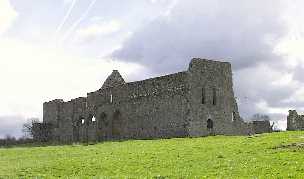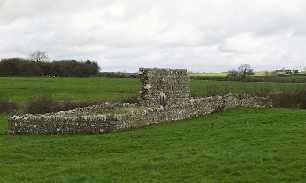| Manister Abbey

© Monasteranenagh Cistercian Abbey
Monasteranenagh Cistercian Abbey derives its name from Manister
an Aonaigh, the monastery of the fair, after a fair that was held here
in ancient times. Mass was celebrated here on New Year's Eve 1999, and
the Abbey was lit up in honour of the new Millennium.

© Chapel at Monasteranenagh Abbey
The ruins consist of a church, which dates from about 1170
to 1220, and an early Gothic chapter house. The remains of what was probably
the abbey's guesthouse are a short distance away. Stillborn children were
once buried within the ruins of the Abbey's guesthouse.

© Guesthouse at Monasteranenagh Abbey
The ruins are quite extensive, and are in good repair. The main window
frame of the church is still intact. The roof collapsed in 1874. The tower
fell in 1806. Only walls and gables remain of the church. The interior
of the abbey was used as a burial ground until the 1970's. The oldest
headstone that we found within the abbey was in memory of Mary Duiry(?)
who died in November 1782, aged 58 years. Fr James Ryan, who died 30th
April 1795, aged 67 years, is also buried here.
Turlough O'Brien, King of Munster, founded a monastery of Cistercian
monks here in 1148 dedicated to the Blessed Virgin. Manister was a daughter
house of Mellifont Abbey in Co. Louth and Manister itself had daughter
houses established in Abbeydorney (1154), Middleton (1180) and Holy Cross
(1181). Manister was a pre-Norman monastery, sometimes called Monasternenagh.
It is believed that there were up to 1,500 monks here by the fourteenth
century. In the 15th century, there were three chapels in each arm of
the transept.
In 1228 the Irish monks with the help of the O'Brien's, the Kings of
Thomond, drove out the abbot and the non-Irish monks, who were mainly
of Norman descent. They were excommunicated for revolting against their
ecclesiastical superiors. Using armed force Hubert de Burgo, the bishop
of Limerick, recaptured the abbey, and reinstalled the monks who had been
driven out.

© Interior of Manister abbey
In 1307 Gerald, Earl of Desmond, was visiting the abbot when captured
by O'Brien of Thomond. In 1540 the monastery at Manister was dissolved,
although the monks were left in possession of the abbey.
In 1579 Sir William Malby led the English in a battle against the Irish
and Spaniards. Sir John of Desmond led the Irish. The Spanish and Irish
soldiers took shelter in Monasternenagh. The abbot helped in a battle
against Malby but they lost. Malby burned the abbey.
Locals were also killed at the abbey by Malby's soldiers. The Earl of
Desmond saw the battle from Tory Hill. The English fired at Irish and
Spanish soldiers who were sheltered in the abbey causing great damage
to the building.
However, the monastery was not destroyed until 1585, when it became the
property of Sir Henry Wallop. He plundered and robbed all of its valuables,
before destroying the monastery.


|